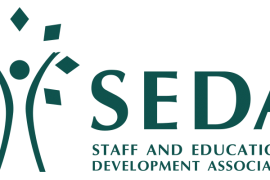My journey as a scholar of teaching in learning
In a companion article, I reflected on how satisfying my career as an education focused academic has been. Alongside a love of teaching, I have developed a love of social science methods and approaches (which is a long journey for a biochemist!).
I’ve been able to use these research approaches to better understand my students, improve my teaching, and evaluate and evidence the quality of my educational work. This has made my work more fun, because creative and exploratory teaching has become both a pedagogical adventure and a rich source of research data and collaborations with my colleagues and students.
I’ve also had the pleasure and privilege of supervising and advising honours, masters, and PhD students from a variety of backgrounds – philosophy, biomedicine, biochemistry, and communication – to do research on teaching and learning, publish, present, and grow.
Of course, as an education focused (EF) academic I have used this work as evidence for my promotion applications. At each stage my assessors have been interested in my work, but sometimes they’ve been unclear on how to evaluate it because they were not used to seeing SoTL.
In the companion article I briefly discussed SoTL, and the unique opportunity it presents for education focused (EF) academics. The article touched on the diverse methodologies and methods that SoTL can use. This diversity can make it difficult for non-SoTL scholars to recognise excellent SoTL but clearly we, as a University, need to be able to understand what constitutes quality in the SoTL field. This article discusses what excellent SoTL can look like.
What are the markers of excellent SoTL?
Felten’s (2013) work provides us with a helpful set of markers of high-quality SoTL. According to his definition, it is:
- Focused on inquiry into student learning
- Grounded in context
- Methodologically sound
- Conducted in partnership with students, and
- Appropriately public.
This list is a good place to start as we consider how to plan a quality SoTL research program. Let’s consider, in more detail, how these criteria might come to life at Sydney.
With respect to Felten’s criteria (1), (2), and (3), we can consider the following ideas from the literature:
- Quality SoTL projects address educational problems (Bass, 1999) using a defined research question and with consideration of current, relevant scholarship.
- Quality SoTL scholars work with a level of rigour and skill that is comparable to traditional disciplinary research. They use sound and carefully considered methodologies and tools, often incorporating a wide variety of qualitative, quantitative, and mixed-methods approaches to research questions (Divan et al., 2017 and references therein).
- The chosen approaches are valid, reliable, and combined to produce a coherent research study (Onwuegbuzie and Johnson, 2006; Tashakkori and Teddlie, 2010) that often has a pragmatic problem-focused lens (Kaushik & Walsh, 2019; Wilkinson and Dokter, 2023).
With respect to Felten’s criteria (4), we can consider the following ideas from the literature:
- Students, and consideration of their experiences, beliefs, attitudes, behaviours, values, and ways of learning are key to quality SoTL (Matthews et al., 2013). As such, students will be part of a SoTL project, or the project will be aimed at improving aspects of their education.
- If students are research participants, their engagement will involve informed consent in an ethics-approved study. Their opinions or learning artefacts will likely contribute to the research (again, with informed consent under ethics approval). They may also be co-researchers and co-authors on SoTL outputs.
- Some types of SoTL can be done without direct student participation; these might include economic analyses, examination of framework implementations at an organisational level, research with other education stakeholders such as industry and government, or research focussed on academics’ lived experience/behaviours/perceptions. In all cases, however, these projects would be related to university-level student teaching and learning, and would engage stakeholders who have an interest in, or input to, university education work.
With respect to Felten’s criterion (5) we can consider the following ideas from the literature:
- A core tenet of SoTL is its openness to public review through publication or presentation in some form (Hutchings & Shulman, 1999). Quality SoTL outputs must be produced for an audience, and generally will be made public for collegial and scholarly discussion and critique.
- SoTL can be disseminated in journals, but this is not the only way to share the activity, its outputs, and its outcomes. It can also be discussed at conferences, in the media, in visits to other universities, in masterclasses, and in other public platforms such as University meetings, accreditation committees, and curriculum workshops.
- Chick (2022) proposes dissemination of SoTL through “whitepapers, practitioner articles, opinion pieces, policy briefs, memos, grant applications, fact sheets, infographics, diagrams, charts, pictures, stories, videos, blogs and other social media, and books written for mainstream audiences” (p. 25). This potential for widespread, non-traditional dissemination is an opportunity to “not just bring the university to the world, but also involve the world in the university” (Fitzpatrick, 2019, p. 135).
- SoTL may be produced, on commission, for a specialised audience. Wide dissemination of such work might be precluded because it uses confidential intra-organisational data. It will still, however, be open to scrutiny from that organisational audience.
Why dissemination of SoTL is crucial for its impact to be realised
Dissemination of SoTL through quality channels and venues will increase the likelihood that it will have demonstrable impact on the educational endeavour. By disseminating SoTL through quality channels and collecting evidence of its impact in the field, a researcher will be able to demonstrate that their work has import and relevance to students and to other educators. The question of journal publication is, however, particularly interesting in SoTL.
SoTL journals generally have low citation rates, and presentation at a conference or workshop can often be more impactful than journal publication. This is especially true when it comes to connecting with, and influencing the practice of, others. Journals are certainly not the only valuable outlet for SoTL. Conducting and preparing work for public consumption does, however, have many benefits and it is important to enumerate them here:
- Publication and other forms of dissemination drive improvements in research practice and scholarship. Staff who conduct work with the intention of publishing it may well put more time into clearly articulating their research questions, selecting sound methodologies, and carefully analysing their data.
- Peer review from disciplinary education journals (even lower-tier journals) is generally rigorous and thought-provoking, driving reflection and critique.
- Publication helps staff, and the University, create a public profile in the education sphere and engage with the current conversations around education.
- The possibility of publication encourages collaborations between EF staff and other academics; this will drive open discussion around the shortcomings and qualities of our offerings.
- Contemporary debates in SoTL, and the methodologies available, enable collaborations and scholarly impact with other stakeholders such as industry, community partners, and our students.
- These interactions and opportunities for growth increase our stock of knowledge around teaching, improve the ability of EF staff to lead and build the teaching culture at the University, and drive improvements in teaching practice. The personal and professional growth of EF academics as scholars benefits them, other staff, and students.
As the University builds its culture and capability around understanding EF work, our ability to recognise quality SoTL is key. EF research – either discipline-based or SoTL – can be mapped against the research pillar in the Academic Excellence Framework and the Framework was written with the needs of EF academics in mind. Guidelines for recognising quality SoTL (and more generally understanding the work of EF academics) are in preparation for University advisors, supervisors, and promotion committees.
Tell me more
If you would like to meet or work with EF academics, I encourage you to join the Educators Community of Practice to discuss education, education careers, and SoTL.






1 Comment